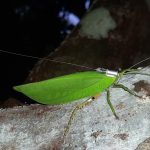
Males of two fan-throated lizard species – Sitana laticeps and Sarada darwini – court females and behave aggressively in front of rival males by rapidly flagging their dewlaps, fan-shaped appendages below their throats.
In a small grassland patch in Maharashtra, these species overlap with each other. Males of both species look different but females look almost identical. Males, therefore, find it difficult to distinguish between mates of their own and other species. This apparent confusion triggers aggression between these species that can escalate to chasing and even physical combat, which is particularly dangerous for the smaller Sitana laticeps.
To avoid aggression, males of the Sitana laticeps species have modified their sexual signals and learnt to distinguish between rivals of their own and other species, finds a new study from Maria Thaker’s lab in the Centre for Ecological Sciences.
In areas where the two species co-exist, Sitana laticeps males have smaller dewlaps and show reduced courtship and aggression. These shifts make them look a little more like females, reducing unwanted attention from the aggressive males of the other species.






